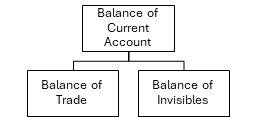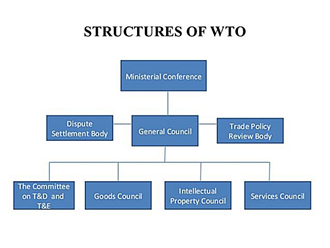-
- The current account measures the transfer of goods, services, income and transfers (real resources) between an economy and the rest of the world. The current account is further subdivided into merchandise account and invisibles account.
- Items are consumption in nature and recurring.
- No effects on assets and liability part for India vis-a-vis rest of the world
Current account is further divided into 2 accounts:
A. Merchandise account (or Goods Account) – It includes exports and imports of goods. It records trade of tangible items (or physical items) i.e. goods and merchandise (including capital goods like machinery).
B. Invisibles account – It includes those intangible transactions which are other than merchandise trade. It is further categorised into 3 parts:
1. Services – It includes trade in services which are also known as invisibles. E.g. – Software, Hotels, Insurance, Financial Services etc.
2. Income (Net Factor Income from Abroad) – It involves net income in the form of rent, wages, profits, and interest. Net factor income is calculated by subtracting factor income paid to foreign workers residing in India from the factor income paid to Indian workers working in foreign countries.
3. Transfer – They are the inward receipts which residents get for free without providing for goods and services in exchange. E.g. – gifts, remittances and external grants. India was the highest recipient of inward remittances at 125 billion USD for the year 2023.
Various Transactional Balances
a. Balance of Trade
Formula: Export of Goods – Import of Goods (In value terms)
-
- Trade Surplus: Exports is more than Imports
- Trade Deficit: Imports are more than Exports
- India generally runs in trade deficits.
b. Balance of Invisibles
Formula: Net Services Exports + Net Transfer Payment + Net Factor Income from Abroad (NFIA)
-
- India is generally a net exporter of services, so invisible account is generally positive.
- Moreover, India is one of the largest recipients of transfer payments so it boosts the invisible account in positive manner.
c. Balance of Current Account

Formula: Balance of Trade + Balance of Invisibles
Current Account Deficit (CAD)
It occurs when less money comes in due to exports and more money goes out due to imports. It is to be noted that moderate levels of current account deficit are acceptable, however the efforts should be made to make sure that this deficit is zero and in the best-case scenario, a current account surplus is most favourable. Despite many efforts, Indian Economy experiences a Current Account Deficit in most of the quarters.
Reasons for High Current Account Deficits
-
- Higher import bills: E.g. – Rise in crude oil price, rise in electrical and electronics equipment may raise the import bill. If exports fail to match the similar rise, it leads to a Current Account Deficit.
- Poor export competitiveness: When the items of exports are not competitive enough and other countries eat market share of exports from India, it leads to lower exports. Moreover, India has yet not integrated with the global value chain when it comes to high-end manufacturing. Thus, it lowers India’s export earnings and disproportionately increases imports of costly goods.
- Global economic slowdown: It reduces the demand for human resources in the domestic economy. This may lead to lower factor income as well as transfers like remittances from abroad.
- Trade wars: This often leads to artificial creation of mismatch in demand and supply which impacts imports as well as exports.
- Unilateral sanctions: Certain economic sanctions by one country over another lead to sudden fall in supply of essential items like crude oil, food etc. This increases global prices and leads to widening the current account deficit.
- Over dependence on tourism: If an economy is overly dependent on tourism, then lower foreign tourist arrival due to geopolitical tensions or pandemic-induced travel ban may lead to High CAD. E.g. – Sri Lanka, Greece.
Spread the Word



